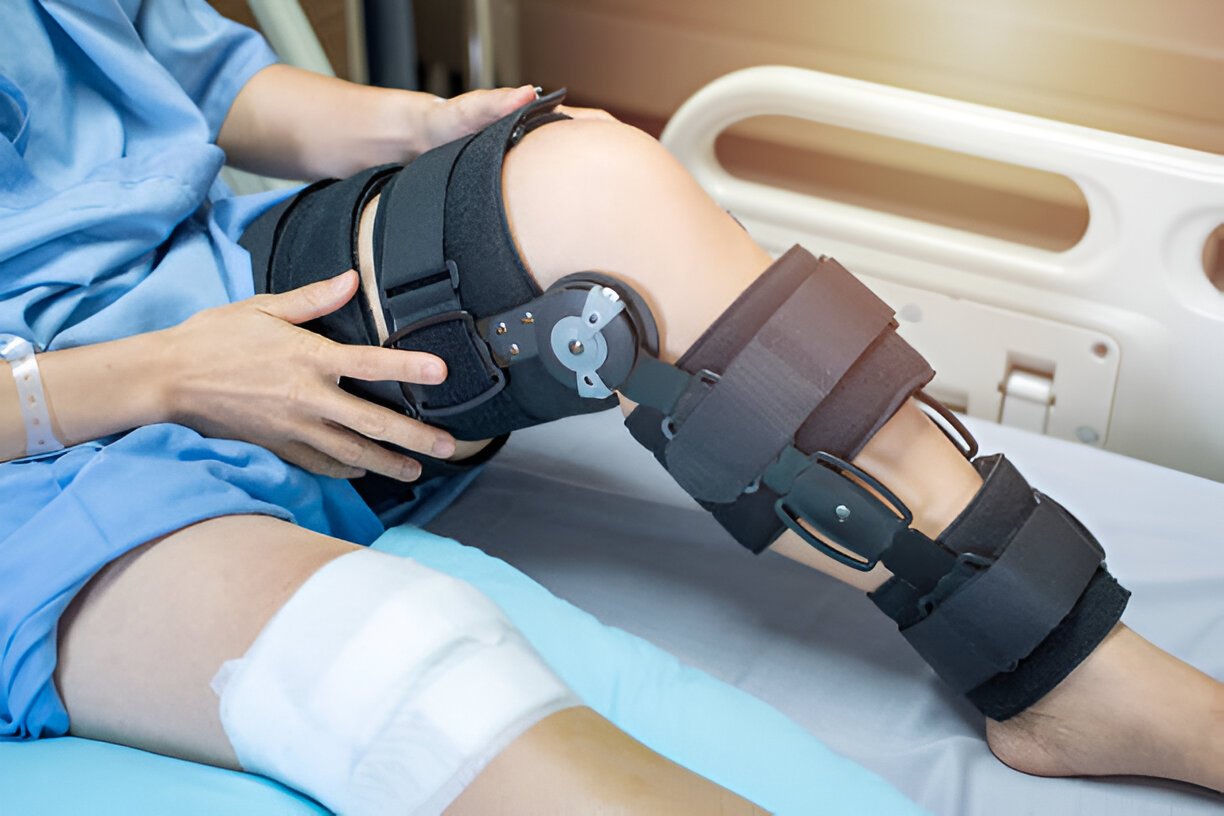
Image Credit: Istock Photo
In the realm of orthopedic support, the knee brace stands out as a pivotal aid for individuals grappling with knee pain, arthritis, and injury recovery. These supports are designed not just for athletes but for anyone who might be seeking relief from discomfort or looking to prevent knee injuries.
With a vast array of options available, from knee braces for pain to those specifically tailored for arthritis, understanding the significance and application of each type is crucial. The proper knee brace can offer unparalleled support, aiding in both recovery and prevention, making it a subject worth delving into for anyone concerned with knee health.
This article aims to explore the various types of knee braces, ranging from those best suited for mild discomfort to the best knee brace options for more severe conditions. It will detail the benefits and uses of knee braces, providing insight into how they can aid in managing knee pain, enhance mobility, and support the knee during physical activities.
Additionally, guidance will be given on how to choose the right knee brace, considering factors such as the level of support needed, the specific condition being addressed, and personal comfort. By understanding these critical aspects, readers will be better equipped to find a knee brace near me that offers the optimal balance of protection and flexibility, ensuring they can continue their daily activities with confidence and comfort.
Types of Knee Braces
Knee braces are categorized based on their function and design, each tailored for specific conditions and needs.
Functional Braces
Functional braces support knees that are already injured, aiding in stability and movement control post-injury or surgery. They are particularly beneficial for conditions like ACL injuries or following reconstructive surgery, helping to reduce knee instability.
Rehabilitative Braces
These braces limit harmful knee movements during the rehabilitation process after surgery or injury. They protect the knee joint and support controlled motion, facilitating recovery while preventing further damage.
Prophylactic Braces
Designed mainly for athletes, prophylactic braces prevent knee injuries by stabilizing the joint during high-risk sports activities. They are commonly used in contact sports to protect against ligament injuries.
Unloader Braces
Unloader braces are specifically designed for arthritis sufferers, reducing pain by shifting stress from the affected knee compartment to a stronger one. They are ideal for individuals with unicompartmental osteoarthritis.
Patellofemoral Braces
These braces help manage pain associated with patellofemoral issues by improving patellar tracking and alignment. They are effective in distributing forces more evenly across the patellofemoral joint.
Knee Immobilizer Braces
Knee immobilizers are used post-surgery or after serious injuries for total knee immobilization. They consist of rigid structures that prevent knee movement, aiding in the healing process.
Knee Sleeves
Offering the least support, knee sleeves provide compression, enhancing proprioception and offering mild pain relief. They are commonly used for minor injuries and during recovery stages to maintain knee activity.
Benefits and Uses of Knee Braces
Knee braces offer essential benefits, enhancing recovery and performance across various activities. Here are the key advantages:
Structural Support
Knee braces provide crucial stability for weakened or injured knees. Functional, rehabilitative, and prophylactic braces are designed to support unstable joints, aiding in recovery and preventing further injuries. They help maintain proper alignment, especially after surgeries such as ACL reconstruction.
Pain Relief
By compressing the knee and offering support, knee braces alleviate pain from conditions like osteoarthritis and patellofemoral pain syndrome. Unloader braces are particularly effective in redistributing stress, easing the burden on painful joints.
Post-surgery Support
Post-operative recovery is critical, and knee braces play a vital role by protecting surgical sites and limiting movement. This ensures safe healing, allowing patients to gradually regain mobility and strength without risking damage to the repaired tissues.
Preventing Injuries
Prophylactic knee braces are used extensively in sports to prevent ligament injuries by providing additional stability. They are essential for athletes participating in high-impact activities, reducing the risk of sprains and strains.
Sports and Physical Activities
Athletes benefit significantly from knee braces, which enhance performance by stabilizing the joint and minimizing injury risks. These braces allow athletes to perform at their best, providing the confidence needed to engage in their sports safely.
4 Best Knee Braces of 2024
When it comes to top knee brace brands, several stand out for their quality and effectiveness.
Bauerfeind Sports Knee Support NBA is renowned for its excellent support and comfort, making it a favorite among professional athletes.
The NEENCA Professional Knee Compression Sleeve offers superior compression and stability, ideal for those recovering from injuries.
For advanced protection, the DonJoy Performance Bionic FullStop Knee Brace features innovative technology to prevent hyperextension, making it perfect for high-impact sports.
Lastly, the McDavid VOW Versatile Over Wrap Knee Wrap provides customizable support and is known for its durability and versatility. Choosing the right knee brace is crucial for both athletes and the general public to ensure optimal knee health and performance.
How to Choose the Right Knee Brace
Consult a Healthcare Provider
When selecting a knee brace, it’s crucial to consult with a healthcare provider. They can guide you based on your specific medical needs and recommend whether a hinged knee brace for stability or a compression sleeve for mild pain is appropriate. This professional advice ensures the brace chosen aligns with your health conditions and activity levels.
Factors to Consider
Choosing the right knee brace involves considering several factors such as the severity of the injury, desired level of support, and the activities you wish to engage in. For severe injuries, a robust, custom-fitted brace might be necessary, whereas a lighter, over-the-counter brace could suffice for mild issues. Comfort, fit, and function are key to ensuring the brace effectively supports without causing additional discomfort.
Custom-Fitted vs. Over-the-Counter Braces
Deciding between custom-fitted and over-the-counter (OTC) knee braces depends on your specific needs and budget. Custom braces, tailored through precise measurements including possible 3D scans, offer a perfect fit, reducing slippage and increasing effectiveness. OTC braces are more cost-effective and can be sufficient for general support, but may not provide the exact fit of custom options. Always check with your insurance to see what costs are covered.
Also Read: Best Sleep Apnea Pillow Options for CPAP Users
Conclusion
Throughout this comprehensive guide, we’ve navigated the vast landscape of knee braces, spotlighting their pivotal role in managing knee pain, enhancing mobility, and facilitating injury recovery. We’ve delved into the different types designed to cater to various needs—from functional and rehabilitative braces that offer substantial support in the wake of injury or surgery to unloader and patellofemoral braces that target specific conditions like arthritis and patellofemoral pain syndrome.
Emphasizing the preventative and rehabilitative benefits of knee braces underscores their significance not only for athletes but for anyone seeking to maintain knee health or recover from injury. The proper selection and use of a knee brace can be a game-changer in terms of improving quality of life, preventing further injury, and supporting overall knee functionality.
FAQs
1. How long should a knee brace be worn each day?
In the early stages of recovery from a knee injury, it is advisable to wear a knee brace for intervals of 2 to 4 hours. As the knee starts to strengthen and heal, the duration for wearing the brace can be reduced accordingly.
2. Are there times when wearing a knee brace is not recommended?
Yes, wearing a knee brace is not recommended if it is too tight as this can disrupt venous circulation, leading to swelling and edema in the leg. It is generally advised to remove the brace when sitting for extended periods or sleeping at night to avoid these issues.
3. What type of knee brace is commonly recommended by doctors?
Doctors frequently recommend unloader braces for individuals suffering from knee arthritis, as these braces help to alleviate the load on the affected knee joint.
4. What are the potential drawbacks of using a knee brace?
While knee braces are beneficial for support and stability, they should not be relied upon as the sole treatment. A significant disadvantage is the potential weakening of the muscles around the knee, as the brace can lead to reduced muscle activity and subsequent atrophy over time.








